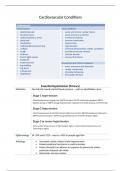Cardiovascular Conditions
Essential Hypertension (Primary)
Definition Persistently raised arterial blood pressure – with no identifiable cause
Epidemiology M: 34% and F:32% - rises to >60% in people aged 60+
Aetiology Increased cardiac output (early hypertension)
Raised peripheral resistance in small arterioles
Renin released from kidneys in response to glomerular under-
perfusion/reduced salt intake
Autonomic nervous system
, Causes: arteriosclerosis (hardening/stiffening of artery walls) and
atherosclerosis (patchy accumulation of fat in arterial walls)
Risk Factors Age, sex [up to 65 M>F, and 65-74 W>M], ethnicity, social deprivation,
lifestyle, stress/anxiety
Symptoms Severe headaches, chest pain, dizziness, difficulty breathing, nausea,
vomiting, blurred vision or other vision changes, anxiety
Signs
Investigations BP reading = above 140/90 (suspect HTN), over 180/120 (opt for
ABPM/HBPM
If 180/120+ (and presents life-threatening symptoms) = same day
referral for elevated HTN
No symptoms = carry out tests for organ damage (if present start
treatment immediately
No organ damage = repeat BP within seven days
Must be confirmed with:
ABPM – 2 measurements per hour during waking hours (14
measurements on average)
HBPM – (if ABPM not tolerated) 2 measurements, 1 minute apart;
twice daily (morning and evening) for 4-7 days
TARGET ORGAN DAMAGE:
- 12-lead ECG for left-ventricular hypertrophy
- Renal function tests and urine tests (protein/albumin/blood)
- Eye screening/fundoscopy for hypertensive retinopathy
(HR: retinal haemorrhage – flame-shaped haemorrhage)
- Assess CV risk: Hba1c and cholesterol
- QRISK3 (10 year risk of person developing cardiovascular disease)
Management Lifestyle changes: diet, exercise, stress, smoking, alcohol, coffee
Under 40, stage 1 HTN, no end organ damage = refer for secondary
HTN investigations
Under 80, stage 1 HTN and 1 of: target organ damage, established
CVD, renal disease, diabetes, QRISK 3 of more than 10% = start
treatment
Under 60, stage 1 HTN and QRISK3 below 10% = consider treatment
Any age with stage 2 HTN = treatment
White coat HTN = patients with persistently raised BP in clinic whose
home/ambulatory blood pressure monitoring readings are lower (>20/10 mmHg)
Signs in clinic = tachycardia, sweating or palpitations
Masked HTN = clinic BP measurements are normal but higher when outside clinic
(ABPM/HBPM)
, Secondary Hypertension
Definition Persistently raised arterial blood pressure – as a result of underlying
condition
Epidemiology
Aetiology Can be a result of:
Renal diseases: renal artery stenosis
Congenital cardiovascular diseases: aortic coarctation
Endocrine diseases: Cushing disease, Conn’s syndrome
Pregnancy
Medication: NSAIDs, steroids, contraceptives
Risk Factors
Symptoms
Signs
Investigations Renal: haematuria, polyuria, proteinuria, elevated creatinine
Aortic coarctation: radio-femoral delay, systolic ejection murmur,
diminished extremity pulses
Renal artery stenosis: abdominal/flank bruits, significant rise in serum
creatinine when starting ACEi
Conn’s syndrome: hypokalaemia
Cushing’s syndrome: osteoporosis, truncal obesity, round face,
muscle weakness, hirsutism, hyperglycaemia, hypokalaemia
Management
Aortic dissection:
Atherosclerosis and constant exposure to high blood pressure =
wakening of aortic wall = intimal tear = blood flow into the tear
SSx: sudden, severe pain of anterior chest, nausea, vomiting,
syncope, sweating
- Can lead to myocardial ischaemia or tamponade
Targets for management:
Aim for BP of <140/90 in people <80 and <150/90 in people >80 [in
clinic]
Exceptions:




